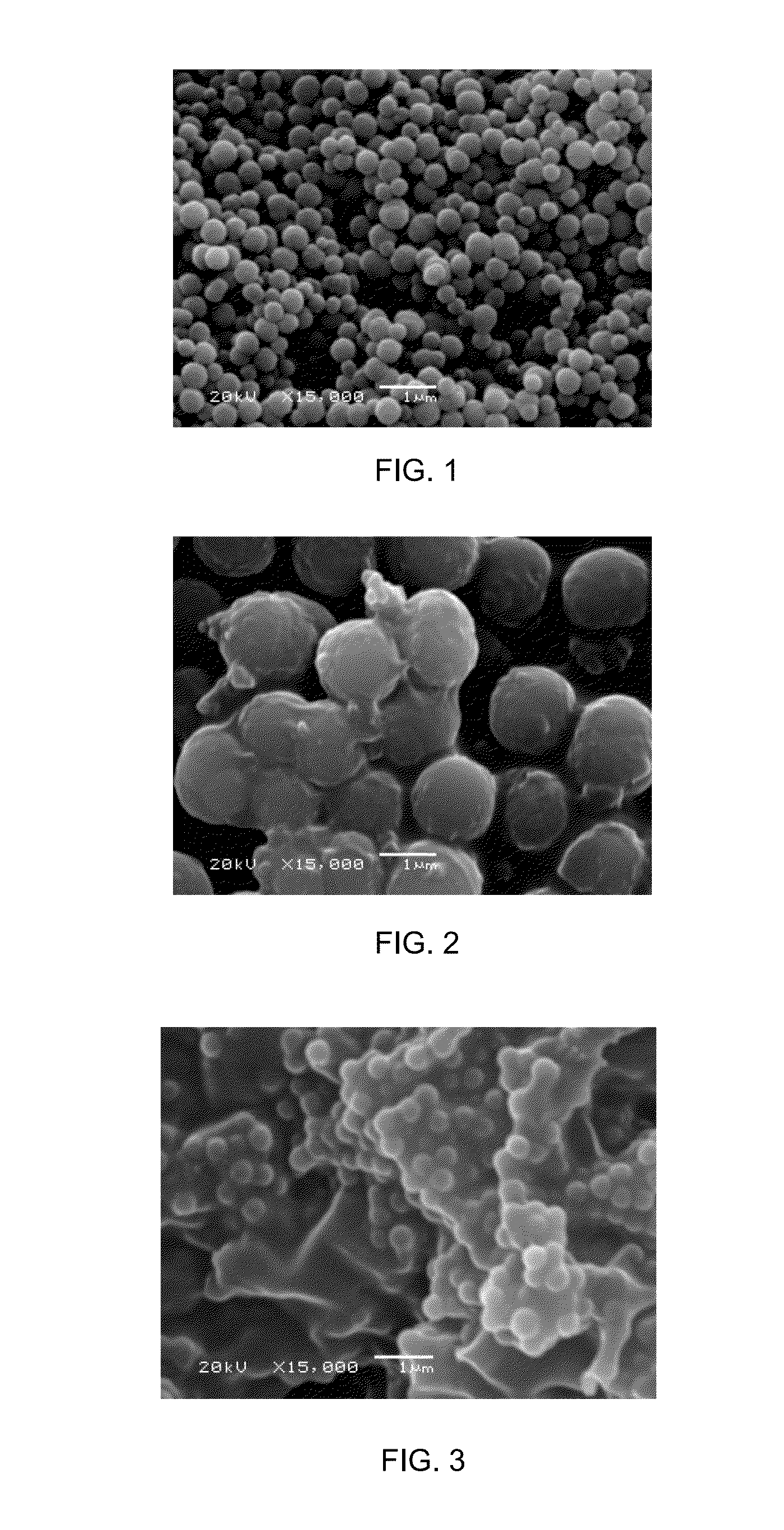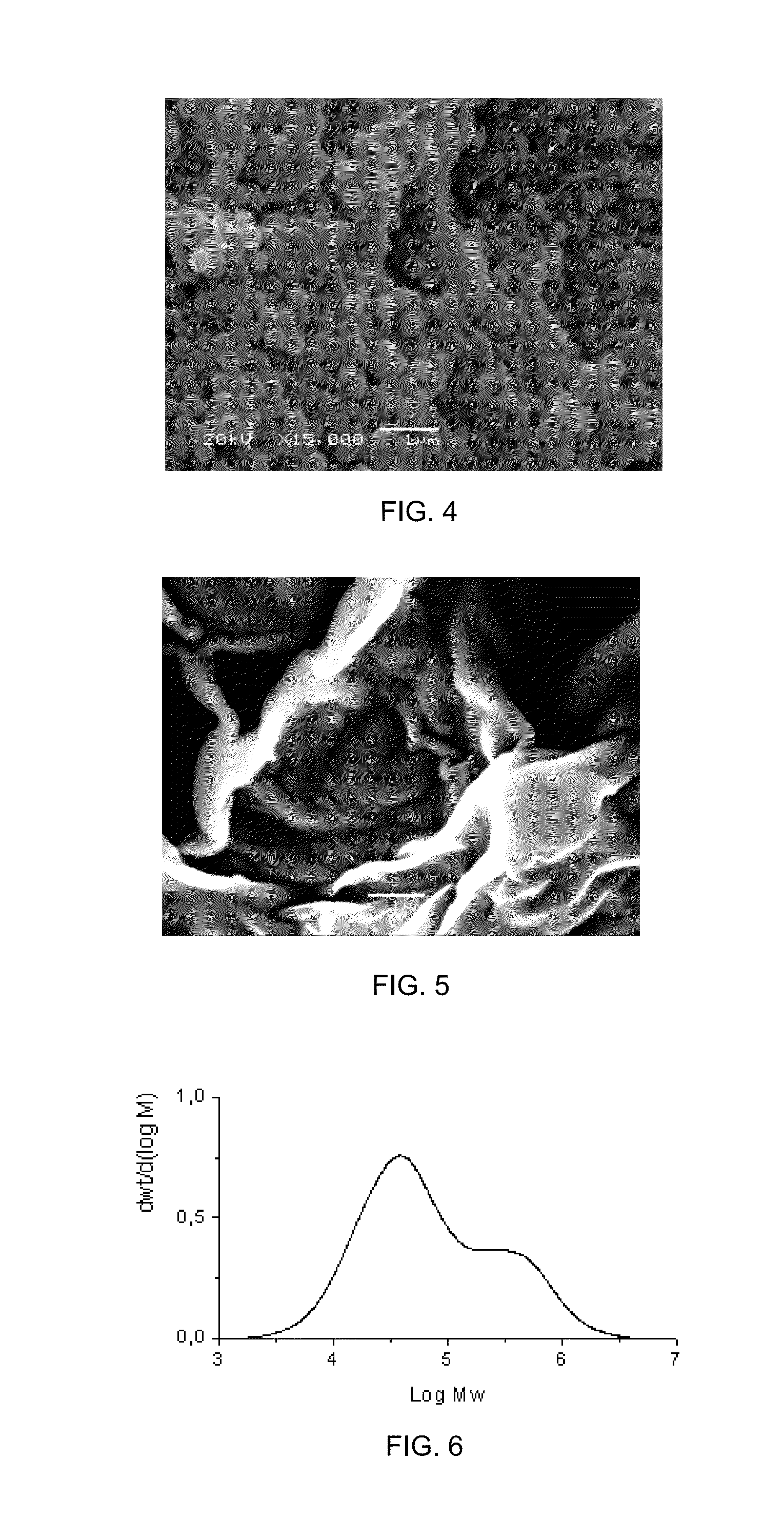Metallocene catalyst supported by hybrid supporting means, process for producing same, polymerization process for producing an ethylene homopolymer or copolymer with broad or bimodal molar mass distribution, use of the supported metallocene catalyst and ethylene polymer with broad or bimodal molar mass distribution
- Summary
- Abstract
- Description
- Claims
- Application Information
AI Technical Summary
Benefits of technology
Problems solved by technology
Method used
Image
Examples
example 1
Preparation of a (Comparative) Conventional Catalytic Support
[0141]This example illustrates the use of TEOS as an agent for preparing a non-hybrid catalytic support based on silica.
[0142]In a solution containing 200 mL ethanol and 40 mL ammonia solution, under stirring of 150 rpm, one adds 10 mL of a solution containing 2 mL TEOS in ethanol. The suspension is left under stirring at the temperature of 25° C. for 2 h, and the resulting solid is dried, washed with ethanol and dried again in vacuum.
[0143]This component obtained was characterized, exhibiting the following characteristics:
[0144]C content:
[0145]2.5% (w / w)—FIG. 1.
[0146]The use of TEOS without octadecyltrimethoxysilane in preparing the support results in a silica with 2.5% carbon. In this case, since the support does not have aliphatic organic groups, the organic content is attributed to the presence of residual ethoxyde groups. According to FIG. 1, this support exhibits a spherical morphology.
example 2
Preparation of Hybrid Catalytic Support
[0147]This example illustrates the use of TEOS and octadecyltrimethoxysilane at the molar ratio of 50:1, as reactants for preparing the hybrid catalytic support having aliphatic organic groups.
[0148]In a solution containing 200 mL ethanol and 400 mL ammonia solution, under stirring of 150 rpm, one adds 10 mL of a solution containing 2 mL TEOS in ethanol. The suspension is kept under stirring at the temperature of 25° C. for 2 h. After this period, one adds, drop by drop, 5 mL of a solution containing 0.085 mL of octadecyltrimethoxysilane in ethanol. The suspension is kept under stirring at the temperature of 25° C. for a further 2 hours, and the resulting solid is dried in vacuum, washed with ethanol and dried again in vacuum.
[0149]This component obtained was characterized, exhibiting the following characteristics:
[0150]C content: 5.1% w / w).
[0151]The carbon content obtained for this support (5.1%) is higher than that observed in the support of ...
example 3
Preparation of the Hybrid Catalytic Support
[0152]This example illustrates the use of TEOS and octadecyltrimethoxysilane at the molar ratio of: 20:1, as reactants for preparing the hybrid catalytic support provided with aliphatic organic groups.
[0153]In a solution containing 200 mL ethanol and 400 mL of ammonia solution, under stirring of 150 rpm, one adds 10 mL of a solution containing 2 mL of TEOS in ethanol. The suspension is kept under stirring at the temperature of 25° C. for 2 h. After this period, one adds, drop by drop, 5 mL of a solution containing 0.21 mL of octadecyltrimethosysilane in ethanol. The suspension is kept under stirring at the temperature of 25° C. for a further 2 h, and the resulting solid is dried in vacuum, washed with ethanol and dried again in vacuum.
[0154]This component obtained was characterized, exhibiting the following characteristics:
[0155]C content: 10.8% (w / w)—FIG. 2.
[0156]The carbon content obtained for this support (10.8%) is higher than that obse...
PUM
| Property | Measurement | Unit |
|---|---|---|
| Fraction | aaaaa | aaaaa |
| Percent by mass | aaaaa | aaaaa |
| Fraction | aaaaa | aaaaa |
Abstract
Description
Claims
Application Information
 Login to View More
Login to View More - R&D
- Intellectual Property
- Life Sciences
- Materials
- Tech Scout
- Unparalleled Data Quality
- Higher Quality Content
- 60% Fewer Hallucinations
Browse by: Latest US Patents, China's latest patents, Technical Efficacy Thesaurus, Application Domain, Technology Topic, Popular Technical Reports.
© 2025 PatSnap. All rights reserved.Legal|Privacy policy|Modern Slavery Act Transparency Statement|Sitemap|About US| Contact US: help@patsnap.com



